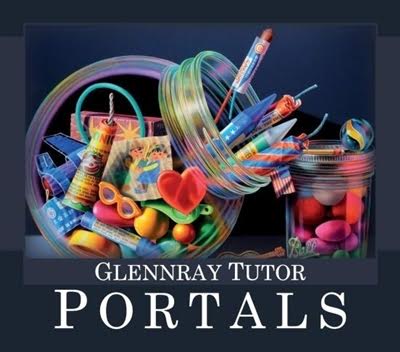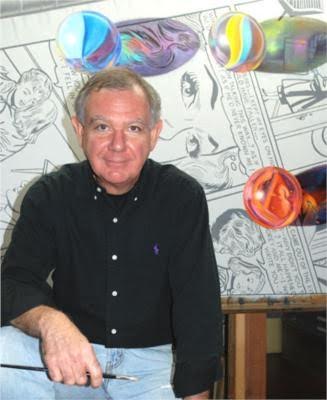Interview by Jana Hoops. Special to the Clarion-Ledger Sunday print edition (November 18)
 Oxfords’s Glennray Tutor–who has been cited as not only one of the world’s top hyperrealist artists, but also one of the three who actually began the movement–shares his visionary style developed over more than three decades in his debut album, Portals.
Oxfords’s Glennray Tutor–who has been cited as not only one of the world’s top hyperrealist artists, but also one of the three who actually began the movement–shares his visionary style developed over more than three decades in his debut album, Portals.
Tutor has expanded the definition of visual art through works that seem to defy the viewer’s imagination with his meticulous technique that blends bright colors with razor-sharp detail and a large measure of metaphor.
Working with still life materials of everyday life, Tutor transforms marbles, comic books, glass jars, retro dinner plates, toys, fireworks, and soft drink bottles into artifacts filled with deeper meanings than meet the eye. Outdoors, he presents nostalgic, barren landscapes filled with abandoned trucks, isolated buildings, roadside signs, filling stations, vending machines and period outdoor furniture, to name a few, with the same intense examination.
Credited as being “the first artist to merge Pop Art with metaphor,” Tutor’s paintings have appeared on TV programs (including Seinfeld) and movies (among them, The Blind Side), as well as record albums, book covers and magazines.

Glennray Tutor
Growing up in southeast Missouri as the only child of native Mississippi parents, Tutor earned a bachelor’s degree in Art and English, followed by an MFA in Painting, at the University of Mississippi. During his career, his art has been included in many group and solo exhibitions, and today his work is shown in numerous public and private museum collections around the world.
Tutor’s schedule of appearances in the Jackson area for Portals, published by Yoknapatawpha Press, includes the following:
Nov. 28 – Fischer Galleries, Jackson, 6 – 9 p.m.
Dec. 4 – Mississippi Museum of Art, Jackson, 4 – 9 p.m.
Dec. 5 – Lemuria Books, Jackson, 5 p.m.
In your book you explain how that, as a child, you enjoyed looking at things (ordinary objects, the stars at night, pretty much everything) and state that “To me, physical objects are portals to a fuller, deeper realization of the world around me.” You later describe how your paintings are made up of different kinds of portals. Please explain this further.
My paintings consist of contemporary objects used metaphorically. The paintings are my arrangement of matter to form an interplay of the visual, emotional, and intellectual. When I say there are “portals” in my paintings, I’m saying that there are layers or dimensions or rooms beyond what a viewer first encounters. It’s sort of like the Chinese Box idea. But the portals contained in a painting of mine are all of equal importance. A viewer can explore these different portals as he desires. Of course, how far into the portals one goes is dependent on the viewer’s perceptive abilities, and intelligence.
For example, my firework series. What the viewer first sees is an arrangement of common fireworks. But let’s look into a further portal in the paintings. The fireworks are metaphors. They are objects like ourselves. They have their existence in the shapes and colors they contain. And they, like ourselves, are going to change. We will change from life to whatever comes next. The fireworks will change into star-backed splendor. Hopefully, we too will achieve such an exalted metamorphosis.
Now, let’s go deeper, into another portal. Looking at the arrangement of the objects one must contemplate whether they have been purposely arranged, or have they arrived at their positions accidentally? Here I’m presenting the ideas of order and happenstance. In our existence was everything set at the instant of the Big Bang? Or is everything happening randomly?
Another portal: the ideas of peace and conflict. One person might use a firework to make a beautiful entertainment. Another person might choose to aim the firework at another person and use it as a weapon. A comment on good versus evil? Responsibility versus recklessness? Yes; both. And I could go on and on. But maybe I’ve illustrated my point.
Describe how you were always absolutely certain that you were born an artist.
I’ve always had a complete sense of self, and how the physical elements around me affect that self. A person knows things about oneself, such as knowing if one likes a particular color or not, or a piece of music, etc. Most people—usually in their 20s —choose a career, usually related to what they like and what they are competent at. I never had that experience.
You state in the book that you’ve “always been able to find treasure” every time you’ve gone looking for it–and “in what generally is thought of as the most unlikely of places.” How do you define “treasure,” and in what ways have you felt it has not been difficult for you to find?
I define “treasure” as something that evokes wonder. This treasure can come to me through any of my senses. It has never been difficult for me to find because my senses, especially my sense of sight, are very acute.
Your artwork is classified as “Hyperrealist,” and you are listed among the top 50 Hyperrealists in the world. Define Hyperrealist art, and why you believe it has become so popular with art lovers today.
The list of the top 50 Hyperrealist artists was compiled earlier this year by Didi Menendez for an article in the magazine Poets and Artists. She is one of the most prominent art arbitrators in the world today; she is a curator, writer, editor, publisher. There are many writings on Hyperrealism and Photorealism–which I am also considered to be a part of–that have appeared in the past 35 years, in which I am included.
One of the more authoritative and beautifully done books presenting and explaining Hyperrealism is Juxtapoz: Hyperreal, edited by Evan Pricco. In this book each artist has a short essay in which he or she describes what they are doing with their art. In this book I’m presented as one of the top 30 Hyperrealists in the world today. Also in this book I am credited as one among three artists who actually began the Hyperrealist movement.
A Hyperrealist painting or a Photorealist painting are paintings that are so technically refined and painted with such clarity that they look more like photographs than paintings. What distinguishes a Photorealist painting from a Hyperrealist painting is that a Hyperrealist painting is dealing with more than simply the physical subject matter it depicts. A Hyperrealist painting is also making a social statement, a statement about a cultural issue, or it is commenting on a moral or ethical issue. Or, as in my case, I’m using objects metaphorically to express my feelings and thoughts about various aspects of reality that intrigue me.
Explain why metaphor is such an important element in your work.
Using metaphor is the only way I know to fully present the ideas that I want to examine in my artwork.
There is a lot of nostalgia represented in your work. Can you speak to that?
This may come as a surprise, but I’m not concerned at all with nostalgia. The world of childhood and the world of adulthood interest me greatly–their similarities and their differences. I’ll use a metaphor to describe this. I’m standing on a shore, which society terms “adulthood;” but the ocean, which we’ll call “childhood,” laps on the shore, wave after wave. For me, it’s difficult to distinguish one from the other.
Throughout the entire book there is an ongoing interview with you, conducted by your son, artist and curator Zach Tutor, and it sheds much light on you and your work. Tell me about how this idea came about. It reads like something the two of you greatly enjoyed doing together!
In the book, I wanted to give the reader a start on understanding what I’m doing with my art. I wanted this to be informative, but also entertaining. My son, Zach, knows as much about art as anyone I’ve known. Having grown up in my studio and through his observations and our discussions, he knows more about me as an artist than anyone else. It occurred to me shortly after I had begun putting the book together that for the text a conversation between the two of us might be the best way accomplish these aims.
You share with readers that it was at age 15 that you discovered that adulthood is simply a “fabrication,” after you sold your entire collection of comic books so you could buy your girlfriend some perfume–and she broke up with you a week later! Why did this lead to your conclusion about adulthood, and how does it affect your art?
That incident is only one among many that influenced my decision regarding adulthood. Look around. Can you find any so-called “adults” anywhere?
Why did it bother you so much, at age 18, to finally see original artwork in a museum and realize that visual brushstrokes were routinely apparent to the viewer in most of the artwork?
I’ll give you two analogies. I don’t want to see how a magician constructs his magic trick. I want to feel the wonder of the “magical” act. If I know how he does it, his performance doesn’t work for me. The same with a pianist. I don’t want to hear all the wrong notes he made while he practiced for the recital. I want to only hear the performance played with perfection. And so it is, for me, with painting. If a viewer, when looking at a painting, must contend with how the painting was technically constructed, with brushstrokes on textured canvas for example, it distracts, to say the least, from his experience of the art itself. When viewing a painting of mine, I want the viewer to experience the art I’m presenting, and nothing else.
Explain your advice to young artists and why you make this suggestion.
If an artist can’t express his own individual ideas then that artist shouldn’t be wasting his time and others’ with his efforts. There is no reason for one artist to re-do some other artist’s expression. But if you do have something artistically fresh to say, then go ahead and get to it.
Glennray Tutor will be at Lemuria on Wednesday, December 5, at 5:00 p.m. to sign and discuss Portals.


Comments are closed.